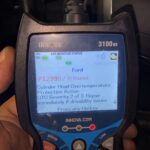Your car’s On-Board Diagnostics II (OBD2) port is a gateway to a wealth of information about your vehicle’s health and performance. Located typically under the dashboard on the driver’s side, this port, standardized across most cars manufactured after 1996, allows you to tap into the intricate data network of your automobile. But what exactly can you learn by plugging into this seemingly simple connector?
Decoding Diagnostic Trouble Codes (DTCs)
One of the primary functions of the OBD2 port is to provide access to Diagnostic Trouble Codes, or DTCs. When your car’s check engine light illuminates, it signifies that the vehicle’s computer has detected a problem. These DTCs are essentially codes that pinpoint the area of the issue, ranging from engine misfires and emissions problems to sensor malfunctions and transmission issues. By reading these codes with an OBD2 scanner, you can gain an initial understanding of what might be going wrong, saving you time and potentially money by directing your mechanic to the specific area needing attention.
Real-Time Data Monitoring
Beyond error codes, the OBD2 port offers access to a stream of real-time data from various sensors throughout your vehicle. This live data can include crucial parameters like:
- Engine RPM: Reveals how fast your engine is turning, essential for understanding engine load and performance.
- Vehicle Speed: Provides accurate speed readings, often more precise than the speedometer itself.
- Coolant Temperature: Monitors engine temperature to prevent overheating.
- Intake Air Temperature: Important for fuel efficiency and engine performance calculations.
- Oxygen Sensor Readings: Crucial for monitoring the efficiency of your catalytic converter and air-fuel mixture.
- Fuel Trim: Indicates how the engine’s computer is adjusting fuel delivery to maintain optimal air-fuel ratio.
- Battery Voltage: Monitors the health of your car battery and charging system.
This real-time data is invaluable for diagnosing intermittent issues, monitoring engine performance while driving, and understanding the immediate effects of changes you make to your vehicle.
Vehicle Identification and Information
The OBD2 port can also be used to retrieve your Vehicle Identification Number (VIN) electronically. This is useful for quickly verifying your car’s identity and accessing vehicle-specific information. Some advanced OBD2 scanners can also pull other vehicle information directly from the car’s computer, such as the calibration ID and component verification numbers, which can be helpful when performing software updates or replacements.
Emissions Readiness Status
For vehicles subject to emissions testing, the OBD2 port provides access to “readiness monitors.” These monitors indicate whether your car’s emissions control systems have been tested and are ready for an emissions test. Knowing the readiness status can help you avoid failing an emissions test due to recently cleared codes or incomplete system checks.
Understanding what information your OBD2 port provides empowers you to be a more informed car owner. While it’s not a magic bullet for auto repair, it offers valuable insights into your vehicle’s inner workings, aiding in diagnostics, maintenance, and overall vehicle health management. Investing in a basic OBD2 scanner can be a worthwhile step for any car owner looking to take a more proactive approach to vehicle care.
